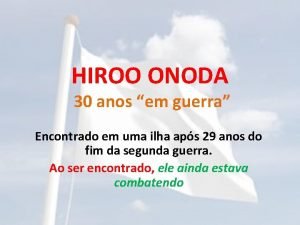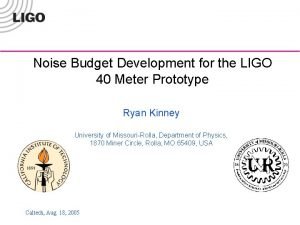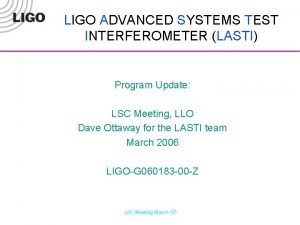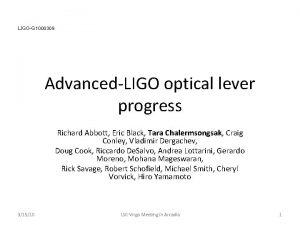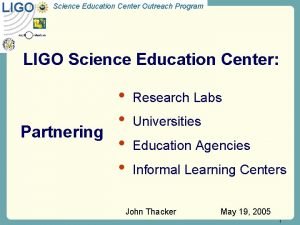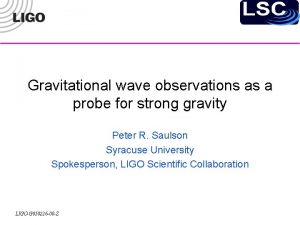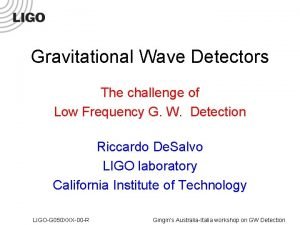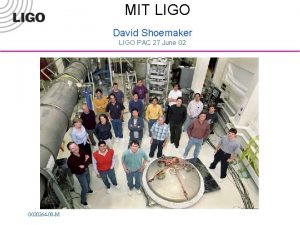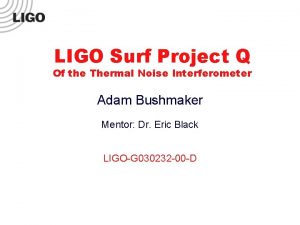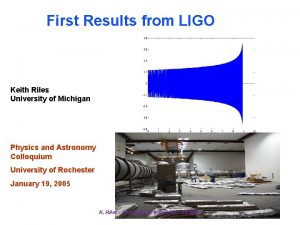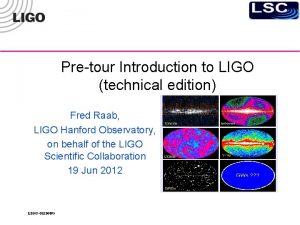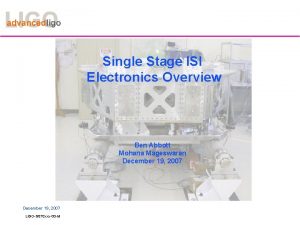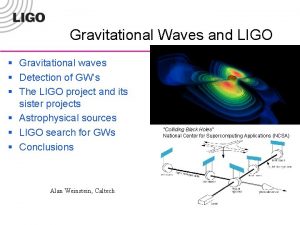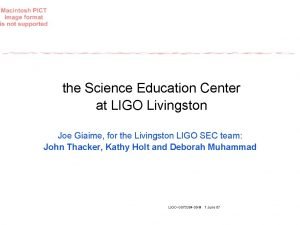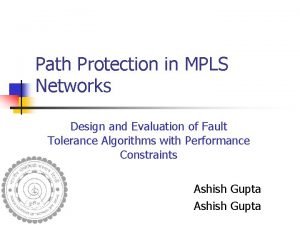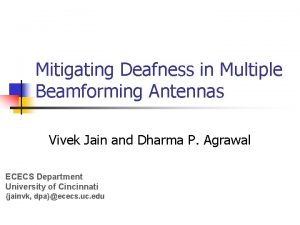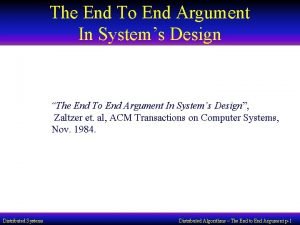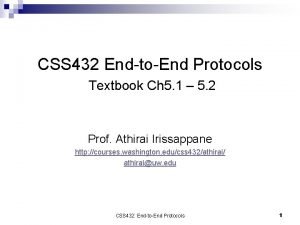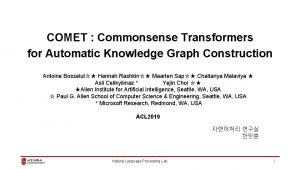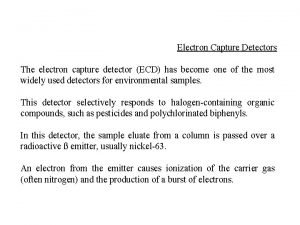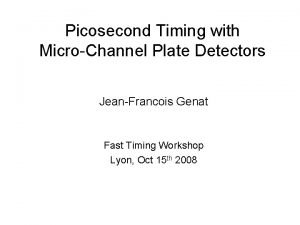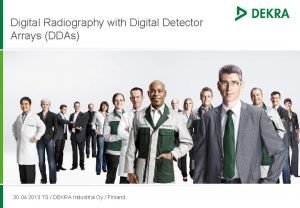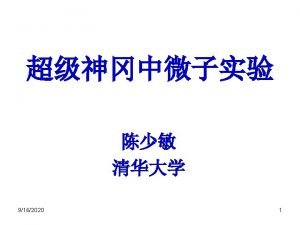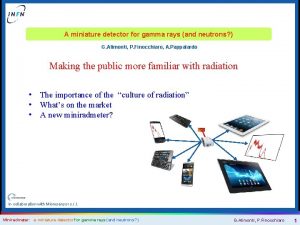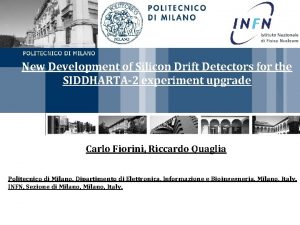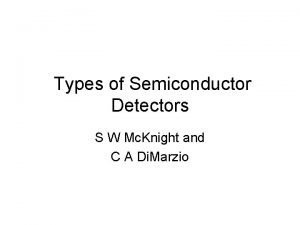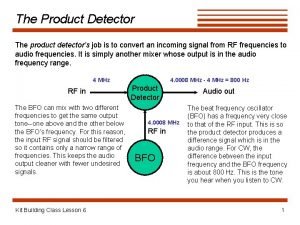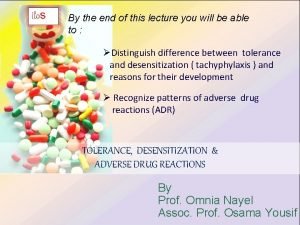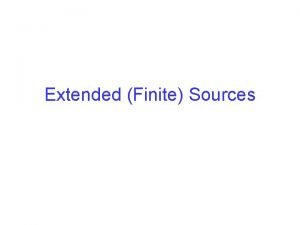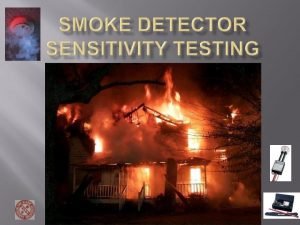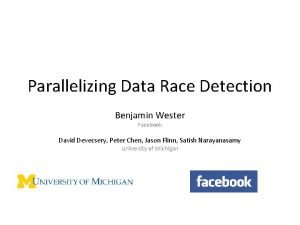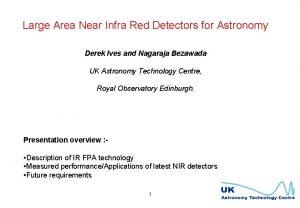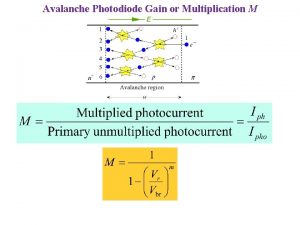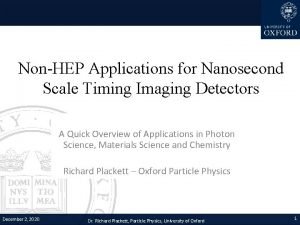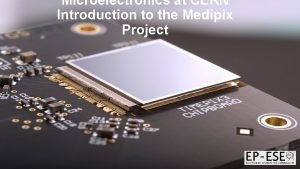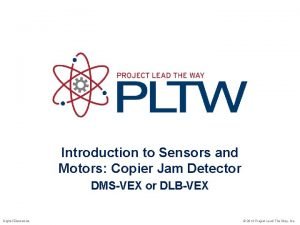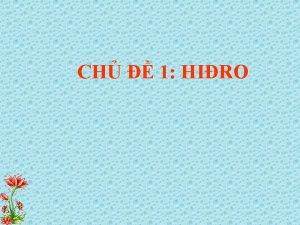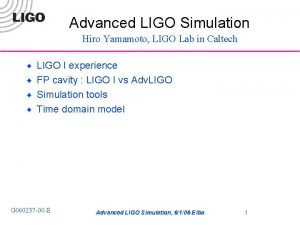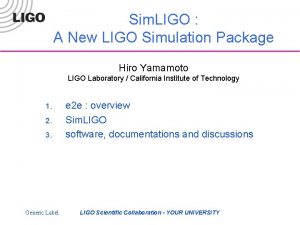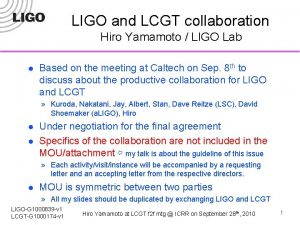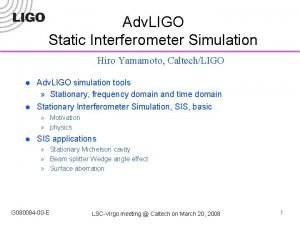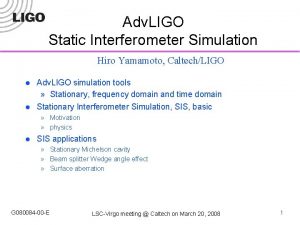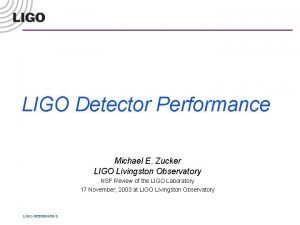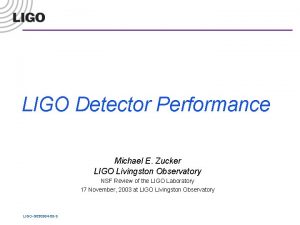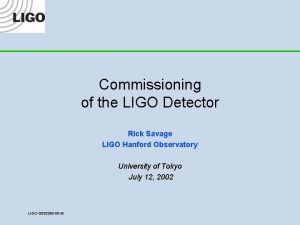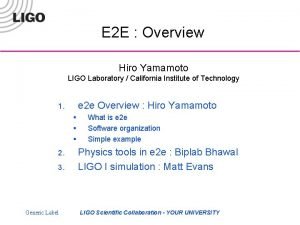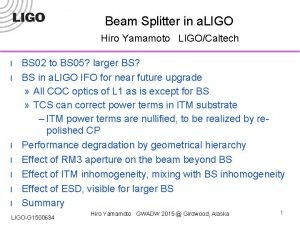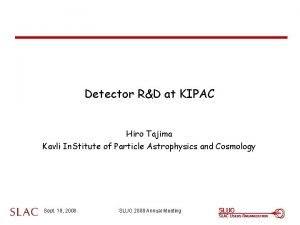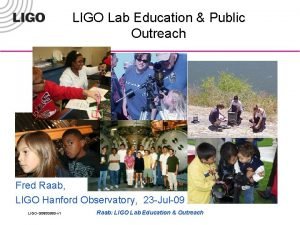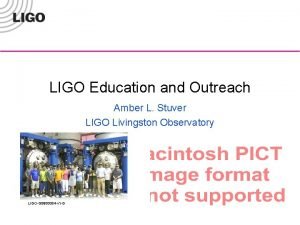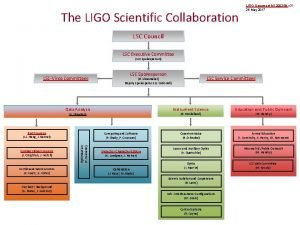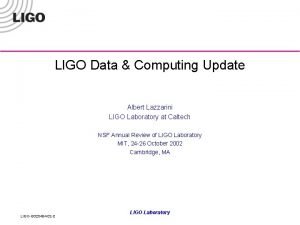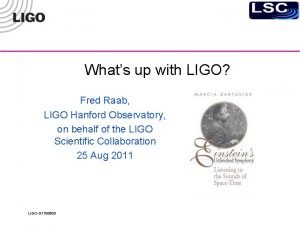End to End Simulation of LIGO detector Hiro
















































- Slides: 48

End to End Simulation of LIGO detector Hiro Yamamoto LIGO Laboratory / California Institute of Technology u u LIGO - Laser Interferometer Graviational Wave Observatory Basics of the Interferometer Detector Interferometer simulation Applications of the simulation LIGO Progress Report : LIGO-G 020007 by Alan Weinstein, Caltech e 2 e of LIGO - UCLA talk

Interferometer for Gravitational Wave detection L 2 E 1 L 1 E 1 - E 2∝ L 1 -L 2 h~10 -23 L 1 -L 2~10 -19 m e 2 e of LIGO - UCLA talk 2

The Fabry-Perot Cavity - the most important dynamics - e 2 e of LIGO - UCLA talk

Basic ingredients of LIGO f. L freq f. L-f. RF f-2 EOM f. L PD shot noise ~ 1016 /s Signal to DOF to force f. RF e 2 e of LIGO - UCLA talk Seismic motion ~ 10 -6 m Seismic Isolation f-6 Laser Thermal noise ~ k. T

Astrophysical sources: Thorne diagrams LIGO I (2002 -2005) LIGO II (2007 - ) Advanced LIGO seimic thermal e 2 e of LIGO - UCLA talk quantum 5

Hanford Observatory (H 2 K and H 4 K) LIGO sites 4 km + 2 km Hanford, WA (LHO) • located on DOE reservation • treeless, semi-arid high desert 4 km Livingston Observatory (L 4 K) • 25 km from Richland, WA • Two IFOs: H 2 K and H 4 K Livingston, LA (LLO) • located in forested, rural area • commercial logging, wet climate • 50 km from Baton Rouge, LA • One L 4 K IFO Both sites are relatively seismically quiet, low human noise - NOT!! e 2 e of LIGO - UCLA talk 6

Logging at Livingston Less than 3 km a few 100 meters away… Dragging big logs … Remedial measures at LIGO are in progress; this will not be a problem in the future. e 2 e of LIGO - UCLA talk 7

International network Simultaneously detect signal (within msec) LIGO GEO Virgo § detection TAMA confidence § locate the sources § verify light speed propagation § decompose the polarization of gravitational waves AIGO e 2 e of LIGO - UCLA talk §Open up a new field of astrophysics! 8

Control Room time frequency Spectrogram e 2 e of LIGO - UCLA talk

How does the signal look like Frequency (Hz), Df = 16 Hz 1. 4/1. 4 Solar Mass NS/NS Inspiral signal in AS_Q. . . (Lormand, Adhikari) 103 102 GPS time (S), DT = 0. 062 s e 2 e of LIGO - UCLA talk 14

Sensitivities of LIGO 3 interferometers e 2 e of LIGO - UCLA talk

Improvements of sensitivities of Hanford 4 k interferometer e 2 e of LIGO - UCLA talk

Different cultures in HEP and GW - my very personal view High Energy Physics Gravitational Wave Detection group people know of simulation very few people know of simulation and hardware developments go side-by-side, stimulating each other simulation is used only when there is no other way, and a model is developed only for that problem. fortran, matlab, mathematica, Lab. View, etc simulation is used to understand the integrated system overall performance is maintained by noise budgets assigned to each subsystem hardware people intend to use simulation to understand problems hardware people try to address problems by dealing with hardware use of simulation for data analysis is a well known procedure simulation for data analysis is non existent e 2 e of LIGO - UCLA talk

LIGO End to End Simulation the motivation u u Assist detector design, commissioning, and data analysis To understand a complex system » back of the envelope is not large enough » complex hardware : pre-stabilized laser, input optics, core optics, seismic isolation system on moving ground, suspension, sensors and actuators » feedback loops : length and alignment controls, feedback to laser » non-linearity : cavity dynamics to actuators » field : non-Gaussian field propagation through non perfect mirrors and lenses » noise : mechanical, thermal, sensor, field-induced, laser, etc : amplitude and frequency : creation, coupling and propagation » wide dynamic range : 10 -6 ~ 10 -20 m u As easy as back of the envelope e 2 e of LIGO - UCLA talk

E 2 E perspective u u u e 2 e development started after LIGO 1 design completed (1997 ~ ) LIGO 1 lock acquisition was redesigned successfully using e 2 e by M. Evans (2000 ~ 2001) Major on going efforts for LIGO I (2001 ~ ) » Realistic noise of the locked state interferometer » Effect of thermal lensing on the lock acquisition u Efforts for Advanced LIGO (2000 ~ ) » Development of optics and mechanics modules » Trying to expand users who can contribute – A. Weinstein (CIT), J. Betzwieser (MIT), M. Rakmanov (UF), M. Malec (GEO) e 2 e of LIGO - UCLA talk

End to End Simulation overview u General purpose GW interferometer simulation framework » Generic tool like matlab or mathematica » Time domain simulation written in C++ » Optics, mechanics, servo, . . . – time domain modal model, single suspended 3 D mass. – analog and digital controller - ADC, DAC, digital filter, etc u End to End simulation environment » Simulation engine - modeler, modeler_freq » Description files defining what to simulate - Simple pendulum, …, full LIGO (constituent files are called “box files” or simply “boxes”) » Graphical Editor to create description files - alfi u LIGO I simulation packages » Han 2 k : used for the lock acquisition design » Sim. LIGO : to assist LIGO I commissioning e 2 e of LIGO - UCLA talk

GW Interferometer simulation - difficulties u Simulate chronologically dependent time series » parallelization is difficult u Control systems connect various subsystems very tightly » optimal choice of system time step is hard u Mirror motions may need quad precision » micro seismic peak ~ 10 -6 m » relative mirror motion of interest for LIGO I ~ 10 -20 m » relative mirror motion of interest for LIGO II < 10 -21 m e 2 e of LIGO - UCLA talk

End to End Simulation coarse view Laser Optics system Mechanical system x, Control system sensor Feedback force • Time domain modal model • Objects : laser, mirror, photo diode, … • Any planar interferometer • Fabry-Perot, Mode cleaner, LIGO I, • Advanced LIGO, … e 2 e of LIGO - UCLA talk actuator • Transfer function using Digital filter • Single Suspended mirror • Mechanical Simulation Engine (object-oriented)

e 2 e Graphical Editor Laser Photo diode mirror propagator e 2 e of LIGO - UCLA talk Photo diode

Simulation engine time loop and independent modules simulation engine GUI construct and init loop data file time evolution loop independent modules Mirror laser photo diode 3 d mass matlab, etc digital filter derived from module class math parser e 2 e of LIGO - UCLA talk M. Evans

e 2 e example - 1 Fabry-Perot cavity dynamics 1 m / s ETMz = -10 -8 + 10 -6 t Resonant at Reflected Power Transmitted Power X 100 Power = 1 W, TITM=0. 03, TETM=100 ppm, Lcavity = 4000 m e 2 e of LIGO - UCLA talk

e 2 e example - 2 Suspended mass with control Suspension point Susp. point Pendulum res. at 1 Hz mixer Force = filter * mass position Mass position Zmass = F/m + w 2 dz S 2 + a S + w 2 e 2 e of LIGO - UCLA talk Control on at 10

FUNC primitive module - command liner in GUI u u u GUI is not always the best tool FUNC is an expression parser, based on c-like syntax all basic c functions, bessel, hermite special functions : time_now(), white_noise, digital_filter(poles, zeros), fp_guoypahse(L, R 1, R 2), … predefined constants : PI, LIGHT_SPEED, … inline functions : leng(x, y) = sqrt(x*x+y*y); L = leng(2, 3); mixer module gain = -5; lock. Time = 10; out 0 = if ( time_now()<lock. Time , in 0+gain*in 1 ); e 2 e of LIGO - UCLA talk

e 2 e physics Time domain simulation u u Analog process is simulated by a discretized process with a very small time step (10 -7~ 10 -3 s) Linear system response is handled using digital filter » » u e 2 e DF = PF’s pziir. m (bilinear trans (s->z) + SOS) + CDS filter. c Transfer function -> digital filter Pendulum motion Analog electronics Easy to include non linear effect » Saturation, e. g. u A loop should have a delay » Need to put explicit delay when needed » Need to choose small enough time step e 2 e of LIGO - UCLA talk

e 2 e physics Fields and optics u Time domain modal model » field is expanded using Hermite-Gaussian eigen states » Perturbation around resonant state u Reflection matrix » » » u tilt Completely modular » Arbitrary planar optics configuration can be constructed by combining mirrors and propagators u u Photo diodes with arbitrary shapes can be attached anywhere Adiabatic calculation for short cavities for faster simulation e 2 e of LIGO - UCLA talk

e 2 e physics Mechanics simulation (1) Seismic motion from measurement 3 » correlations among stacks » fit and use psd or use time series (2) Parameterized HYTEC stack » Ed Daw (3) Simple single suspended mirror » M. Rakmanov, V. Sannibale » 4/5 sensors and actuators » couple between LSC and ASC (4) Thermal noise added in an ad hoc way » using Sam Finn’s model e 2 e of LIGO - UCLA talk 4 2 1

Mechanical noise of one mirror suspended mirror (transfer function or 3 d model) (power spectral density) seismic isolation system (transfer function) seismic & thermal noises seismic motion (power spectral density) e 2 e of LIGO - UCLA talk

Sensing noise Shot noise for an arbitrary input Average number of photons by the input power of arbitrary time dependence Average number of photons Actual number of photons which the detector senses. Simulation option Shot noise can be turned on or off for each photo diode separately. #photons Actual integer number of photons e 2 e of LIGO - UCLA talk time

First LIGO simulation Han 2 k u u Matt Evans Thesis Purpose » design and develop the LHO 2 k IFO locking servo » simulate the major characteristics of length degree of freedom under 20 Hz. u Simulation includes » » » Scalar field approximation 1 DOF, everywhere saturation of actuators Simplified seismic motion and correlation Analog LSC, no ASC no frequency noise, no shot noise, no sensor/actuator/electronic noise e 2 e of LIGO - UCLA talk

Fabry-Perot ideal vs realistic ideal Linear Controllers: Realistic actuation modeling plays a critical role in control design. 150 m. A I V e 2 e of LIGO - UCLA talk

Fabry-Perot arbitrary unit Error signal linearization e 2 e of LIGO - UCLA talk

Hanford 2 k simulation setup 6 independent suspended mirrors with seismic noise corner station : strong correlation in the low frequency seismic motion Non-linearity of controller e 2 e of LIGO - UCLA talk

Automated Control Matrix System LIGO T 000105 Matt Evans Field signal Same c code used in LIGO servo and in simulation e 2 e of LIGO - UCLA talk Actuation of mass

Multi step locking State 1 : Nothing is controlled. This is the starting point for lock acquisition. State 2 : The power recycling cavity is held on a carrier anti-resonance. In this state the sidebands resonate in the recycling cavity. State 3 : One of the ETMs is controlled and the carrier resonates in the controlled arm. State 4 : The remaining ETM is controlled and the carrier resonates in both arms and the recycling cavity. State 5 : The power in the IFO has stabilized at its operating level. This is the ending point for lock acquisition. e 2 e of LIGO - UCLA talk

Lock acquisition e 2 e of LIGO - UCLA talk Not experimentally observable real and simulated

Second generation LIGO simulation Sim. LIGO u u Assist noise hunting, noise reduction and lock stability study in the commissioning phase Performance of as-built LIGO » effect of the difference of two arms, etc u Noise study » Non-linearity – cavity dynamics, electronic saturations, digitization, etc » Bilinear coupling u u u Lock instability Sophisticated lock acquisition Upgrade trade study e 2 e of LIGO - UCLA talk

Sim. LIGO A Detailed Model of LIGO IFO u Modal beam representation » alignment, mode matching, thermal lensing u 3 D mechanics » Correlation of seismic motions in corner station » 6 x 6 stack transfer function » 3 D optics with 4/5 local sensor/actuator pairs u Complete analog and digital electronics chains with noise » Common mode feedback » Wave Front Sensors » “Noise characterization of the LHO 4 km IFO LSC/DSC electronics” by PF and RA, 12 -19 March 2002 included e 2 e of LIGO - UCLA talk

Sim. LIGO Noise sources u All major noise sources » seismic, thermal, sensing, laser frequency and intensity, electronics, mechanical u IFO » » u optical asymmetries (R, T, L, ROC) non-horizontal geometry (wedge angles, earth's curvature) phase maps scattered light Mechanics » wire resonances, test mass internal modes u Sensor » photo-detector, whitening filters, anti-aliasing u Digital system » ADC, digital TF, DAC u Actuation » anti-imaging, dewhitening, coil drivers e 2 e of LIGO - UCLA talk

Sim. LIGO System structure e 2 e of LIGO - UCLA talk

Sim. LIGO more realistic LIGO simulation Digital ISC Env LSC ASC IOO COC Put. Digital Diag ETM Optics Elec. Out - analog Suspension ETM LOS telescope pickoff e 2 e of LIGO - UCLA talk 3 D suspended Controller mass w/ OESM

Sim. LIGO Noise components optical lever e 2 e of LIGO - UCLA talk

LIGO data vs Sim. LIGO Strain (h/rt. Hz) Triple Strain Spectra - Thu Aug 15 2002 data and simulation out of date Frequency (Hz) e 2 e of LIGO - UCLA talk rana-1029490757. pdf

Sim. LIGO sensitivity curve u Calculated from a time series of data » » u Major ingredients of the real LIGO included Interferometer, Mechanics, Sensor-actuator, Servo electronics Known noises Signal to sensitivity conversion Demonstration of the capability to simulate the major behavior of LIGO » » » Reliable tool for fine tuning a complex device Almost any assumptions can be easily tested - at least qualitatively Trade study Subsystem design … e 2 e of LIGO - UCLA talk

Power flow in the interferometer Energy loss in substrate Energy loss by mirror ~ 50 ppm e 2 e of LIGO - UCLA talk 48 Kells by Bill

Advanced R&D: Optics Thermal Compensation Thermoelastic deformation Thermal lens 100 nm “Bump” On HR surface • Extend LIGO I “WFS” to spatially resolve phase/ OPD errors • Thermal actuation on core optics In Input Test Mass 100 nm “lens” for Sapphia 1000 nm “lens” for Silika 10 nm “lens” In Beam Splitter e 2 e of LIGO - UCLA talk 49

Dual recycling cavity simulate FAST u u Can be simulated today, but slow… simulation time step = cavity length / speed of light Module based on an approximate calculation of fields in a short cavity runs 500 (~L 2 / L 1 ) faster than simulation using primitive mirrors. M. Rakmanov (UF) worked on a dual recycling cavity formulation and did its validation using matlab and e 2 e primitive optics. Not completed. linear approx. of Ein , z 1 , z 2 for L 2 /c z 1 z 3 z 2 Ein L 1 e 2 e of LIGO - UCLA talk L 2

Adv. LIGO Mechanics Quadruple Pendulum structure e 2 e of LIGO - UCLA talk

Adv. LIGO Mechanics Transfer functions 60 cm e 2 e of LIGO - UCLA talk 60. 1 cm
 Hiroo onoda
Hiroo onoda Hiro rolla mo
Hiro rolla mo Ligo
Ligo Ligogram
Ligogram Ligo science education center
Ligo science education center Ligo
Ligo Ligo challenge xxx
Ligo challenge xxx David shoemaker ligo
David shoemaker ligo Ligo surf
Ligo surf Hanford
Hanford Ligo
Ligo Xxx00m
Xxx00m Ligo
Ligo Ligo science education center
Ligo science education center End to end delay
End to end delay End-diastolic volume vs end-systolic volume
End-diastolic volume vs end-systolic volume Stroke volume definition
Stroke volume definition Multiple procurement cycles
Multiple procurement cycles End-to-end wireframe parsing
End-to-end wireframe parsing End to end delay
End to end delay Explain compiler construction tools
Explain compiler construction tools End to end argument in system design
End to end argument in system design End to end
End to end Compiler front end vs back end
Compiler front end vs back end End to end accounting life cycle tasks
End to end accounting life cycle tasks Comet nlp
Comet nlp Kolondivertikulose definition
Kolondivertikulose definition Electron capture detector
Electron capture detector Image detector
Image detector Delay lock loop
Delay lock loop Digital detector array
Digital detector array Font detector
Font detector Font detector from image
Font detector from image Silicon drift detector explained
Silicon drift detector explained Semiconductor detector
Semiconductor detector What is a product detector?
What is a product detector? Retinoids
Retinoids Source detector
Source detector Walter jaeger smoke detector
Walter jaeger smoke detector Benjamin wester
Benjamin wester Ir detector
Ir detector Hyperbole
Hyperbole Face detection viola jones
Face detection viola jones Thermal conductivity detector
Thermal conductivity detector Schottky detector
Schottky detector Timepix4
Timepix4 Argus smoke detector
Argus smoke detector Medipix cern
Medipix cern 4.1.1 copier jam detector
4.1.1 copier jam detector
